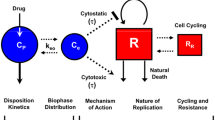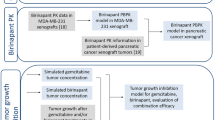Abstract
The mathematical model structure selected to describe system behavior is at least partially dependent on the proposed use of the model. In this paper, a pharmacokinetic(PK)/pharmacodynamic (PD) model for use in drug delivery algorithm synthesis is developed. The antitumor agent 9-nitrocamptothecin (9NC) was administered orally to severe combined immunodeficient (SCID) mice bearing subcutaneously implanted HT29 human colon xenografts, and the effect of 9NC on those xenografts was characterized. Different PK model structures were considered in characterizing the dynamics of the drug concentration in the plasma. Akaike’s Information Criterion (AIC) was used to select the model structure maximizing fit accuracy while simultaneously minimizing the number of model parameters. The resulting PK model was a set of coupled linear ordinary differential equations able to describe the nonlinear dynamic behavior (e.g. plateauing, etc.) of the drug concentrations observed in the plasma. Pharmacodynamics were modeled by characterizing tumor growth in both the untreated and drug-treated animals. The resulting PK/PD model related drug administration to effect, and this model has a structure that facilitates future control algorithm synthesis. Control algorithms in this context would directly utilize PK/PD model predictions. These predictions would be used to determine the amount and frequency of drug administration in order to reduce the tumor burden without violating clinically relevant constraints. This methodology could then be used to aid the clinician in selecting dose levels and schedules, and extension to patient tailored treatment may eventually be feasible with this approach.
Similar content being viewed by others
References
J. H. Lee. Modeling and identification for nonlinear predictive control: Requirements, current status and future research needs. In F. Allgöwer and A. Zheng (eds). Nonlinear Model Predictive Control: Assessment and Future Directions. Birkhäuser, 1999.
M. Morari E. Zafiriou (1989) Robust Process Control Prentice-Hall Englewood Cliffs, NJ
F. Allgöwer, T. A. Badgwell, S. J. Qin, J. B. Rawlings, and S. J. Wright. Advances in control – highlights of ECC ’99, chapter Nonlinear Predictive Control and Moving Horizon Estimation – An Introductory Overview, Springer, London, 1999, pp. 391–449.
C. Cobelli and E. Carson. Modelling methodology for physiology and medicine, chapter 1, An Introduction to Modelling Methodology, Academic Press, San Diego, CA, 2001, pp. 1–44.
C. H. Takimoto and S. G. Arbuck. Cancer chemotherapy & biology, chapter 20, Topoisomerase I Targetting Agents: The Camptothecins (3rd edn). Lippincott Williams & Wilkins, 2001, pp. 579–646.
J. G. Liehr N. J. Harris J. Mendoza A. E. Ahmed (2000) ArticleTitlePharmacology of camptothecin esters Ann. NY. Acad. Sci. 922 216–223 Occurrence Handle11193897
L. L. Jung W. C. Zamboni (2001) ArticleTitleCellular pharmacokinetic, and pharmacodynamic aspects of response to camptothecins: Can we improve it? Drug Resist. Update 4 IssueID4 273–288 Occurrence Handle10.1054/drup.2001.0222
P. Pantazis N. Harris J. Mendoza B. Giovanella (1994) ArticleTitleConversion of 9-nitro-camptothecin to 9-amino-camptothecin by human blood cells in vitro Eur. J. Heamatol. 53 IssueID4 246–248
Y. Pommier P. Pourquier Y. Urasaki J. Wu G. S. Laco (1999) ArticleTitleTopoisomerase I inhibitors: Selectivity and cellular resistance Drug Resist. Update. 2 307–318 Occurrence Handle10.1054/drup.1999.0102
L. L. Jung R. K. Ramanathan M. J. Egorin R. Jin C. P. Belani D. M. Potter S. Strychor D. L. Trump C. Walko M. Faikh W. C. Zamboni (2004) ArticleTitlePharmacokinetic studies of 9-nitrocamptothecin on intermittent and continuous schedules of administration in patients with solid tumors Cancer Chemoth. Pharmacol 54 IssueID6 487–496 Occurrence Handle10.1007/s00280-004-0835-9
National Research Council (ed.). Guide for the Care and Use of Laboratory Animals. Institute of Laboratory Animal Resources Commission on Life Sciences. National Academy Press, Washington, DC, 1996.
R. Horvorka and P. Vicini. Modelling methodology for physiology and medicine, chapter 5, Parameter Estimation, Academic Press, San Diego, CA, pp. 107–152.
E. K. P. Chong S. H. Żak (1996) An Introduction To Optimization Wiley Interscience New York, NY
R. S. Parker. Efficient nonlinear model predictive control: Exploiting the Volterra– Laguerre model structure. In Proceedings of CPC VI. CACHE Corporation, AIChE Symposia Series, 2002.
J. G. Liehr A. E. Ahmed B. C. Giovanella (1996) ArticleTitlePharmacokinetics of camptothecins administered orally Ann. NY Acad. Sci. 803 157–163 Occurrence Handle8993508
H. Akaike (1979) ArticleTitleA Basian extension of the minimal AIC procedures of autoregressive model fitting Biometrika 66 237–242
L. Norton (1988) ArticleTitleA Gompertzian model of human breast cancer growth Cancer Res. 48 7067–7071 Occurrence Handle3191483
A. Asachenkov G. Marchuk R. Mohler S. Zuev (1994) Disease Dynamics Birkhäuser Boston, MA
R. Martin K. L. Teo (1994) Optimal Control of Drug Administration in Cancer Chemotherapy World Scientific River Edge, NJ
R. B. Martin M. E. Fisher R. F. Minchin K. L. Teo (1992) ArticleTitleOptimal control of tumour size used to maximize survival time when cells are resistant to chemotherapy Math. Biosci. 110 221–252 Occurrence Handle10.1016/0025-5564(92)90039-Y Occurrence Handle1498451
R. S. Herbst A-.M. Maddox M. L. Rothenberg E. J. Small E. H. Rubin J. Baelga F. Rojo W. K. Hong H. Swaisland S. D. Averbuch J. Ochs P. M. LoRusso (2002) ArticleTitleSelective oral epidermal growth factor receptor tyrosine kinase inhibitor ZD1839 is generally well-tolerated and has activity in non-small-cell lung cancer and other solid tumors: Results of a phase I trial J. Clin. Oncol. 20 IssueID18 3815–3825 Occurrence Handle10.1200/JCO.2002.03.038 Occurrence Handle12228201
J. H. M. Schellens B. Heinrich M. Lehnert M. E. Gore S. B. Kaye P. Dombernowsky R. Paridaens A. T. Oosterom Particlevan J. Verweij W. J. Loos H. Calvert N. Pavlidis H. Cortes-Funes J. Wanders M. Roelvink C. Sessa K. Seliner P. S. Wissel T. Gamucci A. R. Hanauske (2002) ArticleTitlePopulation pharmacokinetic and dynamic analysis of the topoisomerase I inhibitor lurtotecan in phase II studies Invest. New Drug. 20 83–93 Occurrence Handle10.1023/A:1014454821885
R. Rajendra M. K. Saleem J. H. Schellens D. D. Ross S. E. Bates P. Sinko E. H. Rubin (2003) ArticleTitleDifferential effects of the breast cancer resistance protein on the cellular accumulation and cytotoxicity of 9-aminocamptothecin and 9-nitrocamptothecin Cancer Res. 63 IssueID15 3228–3233 Occurrence Handle12810652
Author information
Authors and Affiliations
Corresponding author
Rights and permissions
About this article
Cite this article
Harrold, J.M., Eiseman, J.L., Joseph, E. et al. Control-Relevant Modeling of the Antitumor Effects of 9-Nitrocamptothecin in SCID Mice Bearing HT29 Human Colon Xenografts. J Pharmacokinet Pharmacodyn 32, 65–83 (2005). https://doi.org/10.1007/s10928-005-2103-y
Received:
Accepted:
Issue Date:
DOI: https://doi.org/10.1007/s10928-005-2103-y




